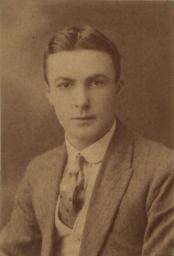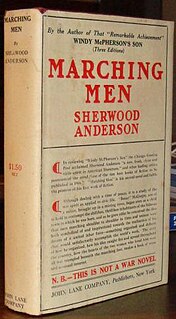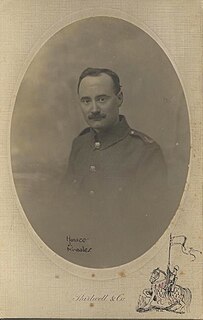Related Research Articles

John Galsworthy was an English novelist and playwright. Notable works include The Forsyte Saga (1906–1921) and its sequels, A Modern Comedy and End of the Chapter. He won the Nobel Prize in Literature in 1932.

Winesburg, Ohio is a 1919 short story cycle by the American author Sherwood Anderson. The work is structured around the life of protagonist George Willard, from the time he was a child to his growing independence and ultimate abandonment of Winesburg as a young man. It is set in the fictional town of Winesburg, Ohio, which is based loosely on the author's childhood memories of Clyde, Ohio.

Sherwood Anderson was an American novelist and short story writer, known for subjective and self-revealing works. Self-educated, he rose to become a successful copywriter and business owner in Cleveland and Elyria, Ohio. In 1912, Anderson had a nervous breakdown that led him to abandon his business and family to become a writer.

Mary Elizabeth Coleridge was a British novelist and poet who also wrote essays and reviews. She wrote poetry under the pseudonym Anodos. Other influences on her were Richard Watson Dixon and Christina Rossetti. Robert Bridges, the Poet Laureate, described her poems as 'wonderously beautiful… but mystical rather and enigmatic'.

Bernard Richard Meirion Darwin CBE JP a grandson of the British naturalist Charles Darwin, was a golf writer and high-standard amateur golfer. He was inducted into the World Golf Hall of Fame.

John Lane was a British publisher who co-founded The Bodley Head with Charles Elkin Mathews.
Charles Elkin Mathews was a British publisher and bookseller who played an important role in the literary life of London in the late 19th and early 20th centuries.

Sir Max Pemberton was a popular English novelist, working mainly in the adventure and mystery genres.

Edward Owen Rutter was an English historian, novelist and travel writer.
Hillard (Hilly) Elkins was an American theatre and film producer.
Stella Benson was an English feminist, novelist, poet, and travel writer. She was a recipient of the Benson Medal.

Guy Victor Baring was a British Army officer and politician. He became a Conservative member of the British House of Commons but was one of 22 Members killed in action in the First World War.

Duncan Frederick Campbell was a Canadian-born British politician and soldier. He served as a Unionist Member of Parliament for North Ayrshire and died while fighting in World War I.
George Donald Valentine (1877-1946) was a Scottish sheriff, and writer of romantic-style short stories, plays and verse. He graduated from the University of Glasgow and was considered for Examinerships in Mathematics and Natural Philosophy at both Glasgow and St Andrews Universities.

Marching Men is a 1917 novel by American author Sherwood Anderson. Published by John Lane, the novel is Anderson's second book; the first being the 1916 novel Windy McPherson's Son. Marching Men is the story of Norman "Beaut" McGregor, a young man discontented with the powerlessness and lack of personal ambition among the miners of his hometown. After moving to Chicago he discovers his purpose is to empower workers by having them march in unison. Major themes of the novel include the organization of laborers, eradication of disorder, and the role of the exceptional man in society. The latter theme led post-World War II critics to compare Anderson's militaristic approach to homosocial order and the fascists of the War's Axis powers.

Windy McPherson's Son is a 1916 novel by American author Sherwood Anderson. It was published by John Lane as part of a three book contract. Windy McPherson's Son is Sherwood Anderson's first novel.
Margaret Leland Goldsmith (1894–1971) was an American journalist, historical novelist and translator who lived and worked primarily in England. She translated Erich Kästner's Emil and the Detectives for the first UK edition.

Arthur "Geoffrey" Herbert Malins was a British film director most famous for camera and editing work on the 1916 war film The Battle of the Somme, which combined documentary and propaganda, and reached an audience of over 20 million viewers.

Horace John Knowles was an author and illustrator. He is remembered mostly for magical depictions of Fairyland in his magnum opus Peeps into Fairyland, as well as for his biblical illustrations. For his first two published books, Legends from Fairyland (1908) and Norse Fairy Tales (1910), he collaborated with his brother Reginald L. Knowles.
Margaret Leonora Eyles was an English novelist, feminist and memoirist. Captivity (1922) has been described by critics as "her strongest fictional expression of the chains that bind women, body and soul."
References
- ↑ "Sherwood Anderson (1876-1941). Alice and The Lost Novel. London: Elkin Mathews and Marrot, 1929". The Library of Virginia. Retrieved 20 April 2012.